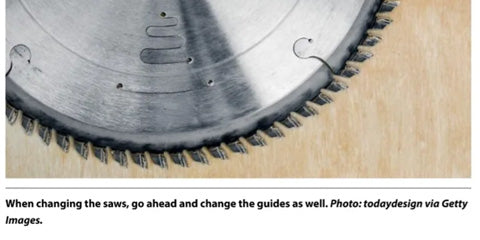By Paul Smith, Ambassador and Consultant for Smith Sawmill Service a BID Group Company with locations in Texas, Louisiana, and North Carolina.
March / April 2024
DON’T SHOOT ME, I’M ONLY THE SAWFILER
I imagine that as sawfilers, we have all experienced that time when our filing room
doors burst open and in comes a person yelling, “What is going on with your saws?”
As the filer, we are taken by surprise, look around, gather our thoughts, and ask,
“What exactly are you talking about?”
Of course all of us in the filing room know that when there’s a problem, the first place
the mill personnel points to is the saws.
The seasoned, experienced filer quickly tries to calm everyone down and starts the
analysis of the problem and how dire it may be.
By simply listening to see if saws are still “in the cut”, the filer determines if the mill is
running. If it is, he sighs a little relief, but if it’s not running, he understands that every
minute is money!
The first step of solving any problem is to gather information/facts. Next, determine
where to look for the problem. And of course, most importantly, help resolve the
problem.
Is the problem bad lumber? Filers, grab your tools and take a close look at those
saws. As professionals, we want to determine exactly what the saw is doing in the
cut and if every board is affected.
Knowing when the saws were taken out and how long they’ve been running lets one
decide if the problem occurred on startup, or if the problem started after the saws
had run for a while. This information can help determine whether the issue was from
any recent saw repair.
If the saw ran the first few cants without any issue, then this should eliminate leveling
or tensioning errors.
On the other hand, if the issue is wavy or wedge lumber on start-up, then there
could be an issue with saw tension.
At this point, the mill is going to initiate a saw change. Once the new saws are on,
the question will be, “Is our problem resolved?”
If it is, the saws now in the hands of the filer are going to be closely inspected.
So, what if the lumber is straight as a board but doesn’t pass a quality check?
A quick look should reveal if any of the saws have met their number one culprit:
metal.
Lost teeth, bent shoulders, and such pretty much mark their territory. If the teeth are
the problem, it’s a good idea to determine if metal or foreign material may have been
hit. If so, try to locate the boards that were the issue.
Planer operators will not want these boards sent through their machines. If it’s
determined that nothing was hit, then the filer would inspect the tipping process in
the filing room and try and determine where the problem exists – annealing, unclean
tools or saws, improper tipping technique should all be considered.
To eliminate as many issues as possible, I suggest when changing the saws, go
ahead and change the guides as well. Guide wear or inconsistencies tell a great deal
about various issues such as lubrication or saw plate issues.
I want to remind those of you out there encountering these issues when gathering
information, include maintenance, filers, and operators. Each department may have
a different perspective but it’s better to have information and not need it, than to
need it and not have it.
A thorough check of the saws, guides, lubrication system, RPMs, alignment, feed
speeds are just a few of the elements that factor into good lumber being produced.
Before startup with change of saws and guides it should be determined that the
lubrication system is working properly.
Consult with the head sawfiler; he can inspect saws and guides as they are installed
to facilitate a successful startup. It must be determined that guides are neither too
tight nor too loose.
At this time, I would also suggest taking a good look at the saws turning full RPMs
before a cant is sent through.
Are the saws standing up straight as full RPM is reached, and not waving?
I’m sure I haven’t covered all that could be wrong with a set of saws, but at this point
if you are continuing to have problems, the maintenance crew should be called in to
inspect bearings and press rollers.
In one of my filing experiences, we had a mill that always had the end of a 12-foot
cant miscut. The result of course affects the bottom line, when 12-foot boards had
to be cut back to 10 foot at the planer.
It was found that the last press roller was not coming off the cant in time and was
causing the cant to be pushed over in the cut at the end of cant. Of course, this was
an easy fix by resetting the press roller timing.
In my day, it was a good rule that if every saw is acting the same, it’s unlikely for it to
be a tension issue.
Today it may be unlikely that every saw will be tensioned the same unless an autotensioner
is involved.
Poor or miscut lumber is not always the saw’s fault or the sawfiler’s, however, it
seems to always be the first place to look at.
It’s my belief that mill personnel come to the filing room first because they know and
depend on the experienced sawfiler to be able to help with any issue, and not just a
saw problem.
Good sawfilers should always be ready and willing to help with any sawmill problem.
Paul Smith is a saw filing consultant and founder of Smith Sawmill Service, now part
of BID Group. You can reach him at paul.smith@bidgroup.ca.



